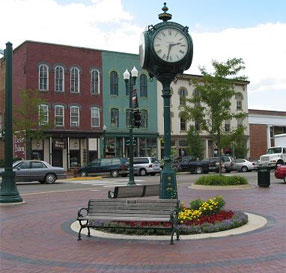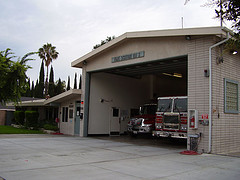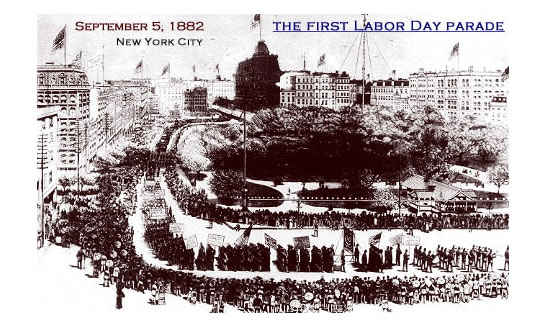“Hockey is more than just a game.
It’s a passion, a dedication.
It draws you in and never lets go.
Hockey is love, hockey is life.
Hockey lives in our hearts.”
On June 19, 1980, a Northwest Orient flight departed Los Angeles International Airport on a non-stop flight to Detroit Metropolitan Airport in Romulus, Michigan. Upon landing, the jetway was pushed up to the plane, the door opened, and the passengers disembarked. I was one of those passengers. I was two months shy of my 15th birthday. My life had changed.
Born and raised in Orange, California, I was a pretty typical middle-class kid in Orange County. I played little league and soccer, I was

The Plaza in Orange, California: my hometown. This park is in the center of the intersection of Chapman and Glassell Streets and is the heart of downtown Orange.
a cub scout, and I ran track for the Peralta Junior High School Patriots. We lived in a nice family-oriented neighborhood where there were lots of kids the same age. We rode our bikes all over our neighborhood and the neighborhoods that surrounded us. We went to
the beaches at Newport Beach and Corona del Mar, and sometimes my older sister took us to Seal Beach. In junior high I joined the ski club and we would go skiing in the mountains every other weekend or so.
The one thing that simply was not on the radar of this California kid: hockey. I had never been on ice skates; we had roller skates and skateboards. I had heard there was an ice rink at the Brea Mall, but I had never been there. Los Angeles had the Kings, but this was pre-Gretzky and to most of us “natives” they were a joke. They played a cold-weather sport in a warm-weather state. For myself and most of my friends it was not our thing. Also, they simply were not good. Who needed a losing hockey team? We had the L.A. Dodgers who regularly battled their way to the playoffs and the World Series. Nolan Ryan pitched for the Angels and Reggie Jackson left the Yankees to come hit home runs for us. We had the Rams. We had the Raiders and the Lakers. Saturday afternoons at our house consisted of college and professional football, baseball, and of course my dad’s beloved bowling. I still can vividly remember “Tips with Earl Anthony.”

Downtown Ann Arbor, Michigan looking east up Liberty Street toward State Street by the U-M campus.
On that June evening in 1980, the first pages of a new chapter in my life began to be written. My dad had accepted a new position with a company in Ann Arbor. While my parents were originally from Michigan, myself and my immediately older and younger brothers, the only three in my family actually born in California, were taken away from the only home we had ever known and found ourselves in this “foreign” land.
That summary of my youthful California may not seem to have anything to do with my love of hockey. In fact, it really only serves to highlight one thing: hockey was not my thing. What it shows is that my life was one thing in California, and would become something else in the Great Lake State.
Human beings are nothing if not adaptable. In the case of a 15-year-old relocated 2,500 miles from home, you adapt or you live in misery. In reality, for a teenager, it is actually a waffling back and forth between the two. I was intrigued by my new state and where I lived in it. We lived in a country neighborhood that had dirt roads. We didn’t have dirt roads in Orange County, unless you counted

Dexter, Michigan. My “second” hometown.
the fire breaks that crisscrossed that hills around town. My high school, in the small town of Dexter, 4 miles west of Ann Arbor, offered agricultural classes as electives. Really? Bizarre. I took Livestock Production I and II, as well as a class in Forestry. I don’t think you would have found those offerings at Villa Park High. In Orange, our house, at the end of a cul-de-sac, had shopping centers on two sides. In Michigan we lived on a golf course and in the evening it was a great place to walk the dogs and explore. I still think that is the best use of a golf course!
At the same time, I missed my home in California. It was the only home I had ever known. I missed my friends, whom I had been in school with since the start. I missed being able to walk to the corner store, and hang out around commercial construction sites and climb walls and fences. I missed being able to ride my bike everywhere. Riding a bike on a dirt country road was a damned tough proposition and not one that I liked at all. But I believe that anyone who finds themselves in a new place, regardless of their age, can’t help but be fascinated by what there is to see that is so fundamentally different from where they came from. Whether visiting or a new resident, we want to see, explore, and absorb all that is new, unique, and different to us. Not only do things often look different, but culturally they are different. Thus it was with hockey. The sport that meant so little to Californians had a lot more significance to the residents of a state that spends 5 months of the year under a blanket of snow and ice.

Yost Arena, home of the University of Michigan Wolverine hockey team, and quite likely the most elegant college hockey venue in use today.
In the first Winter after we moved to Michigan, my dad bought tickets for he, myself, and my brother to attend what would be my first-ever hockey game: the University of Michigan Wolverines versus the Huskies of Michigan Technological University (which happens to be dear ole dads alma mater). My dad, being from Michigan, had grown up with hockey. Life and culture in California just didn’t provide the right opportunity to make the introduction to his kids. He was more of a football guy anyway.
The game was played in Yost Ice Arena, a classic old hockey “barn.” Built in 1926, Yost is a beautiful, commanding brick building on State Street in Ann Arbor and is, in my opinion, still the most incredible college hockey venue there is. I am actually a Michigan State University Spartan fan, but Munn Arena at MSU doesn’t hold a candle to Yost.

Munn Arena at Michigan State University.
U-M has spent a lot of money in renovations of Yost over the years and I hope that they forever appreciate the history and atmosphere of this arena. When I close my eyes and imagine hockey, I see Yost.
Though time warped and tarnished, my memory of this first game is still the cornerstone in the wall of my love affair with hockey. Prior to that night I had never in my life seen first hand anyone skate like that. I had seen Olympic figure skating on TV. I have a vague recollection of the “Miracle on Ice” win in 1980, but I had never truly watched hockey, and what I saw was fast, hard-driving, fast stopping, incredible skating and action. I remember being completely in awe by the players’ ability to control a puck with a stick and to weave their way through the other players to attempt, and in some cases succeed, at scoring. I remember the feel of the air when the players first came out to warm up, their skates stirring up the cool air off the ice and how it wafted over you. Not cold per se, but just a refreshing, awakening cool kiss on the face. To reference back to the opening quote: hockey drew me in and it has never let me go. Michigan Tech won that night. I have no idea the score. It was a big win. Not the game. The effect on me.

Inside Yost Ice Arena. Note the classic lines of the old school arena architecture.
The next year, my dad bought season hockey tickets to U-M. For that first season our seats were near center ice and I grew to love the game more. I could not skate and continued to be amazed how players even stayed on their feet, let alone scored. In the second year of our season tickets however, our seats moved. This would prove to have another big effect on how I enjoy the game. Our seats were moved to the end, home ice. We sat behind the net that U-M had to defend twice in the three periods of play. Now sitting at the 50-yard line of a football game may be the best location to view that game, but in my opinion end ice or the creases are the best places to watch hockey. Why? You can see the most ice, and with a hockey rink being 200 feet long you can still see the action at the other end. When you sit center ice, because of the boards, you lose almost 200 feet of playing surface on your side of the arena. Keeping in mind that the puck is played at ice level, and that a lot of play happens along the boards, I want to see maximum ice. And, as just an aside: in most professional arenas, on one side of the ice you have the player box obstructing your view and on the other side the penalty box obstructs the view. To this day, my preferred seating is in the end or in the crease even with the goal line.

Joe Louis Arena, Detroit, Michigan: home of the Red Wings
After high school it was off to college. Life moved on. Life gets in the way. I didn’t get to hockey games like before, but I did have a new experience that continued the ascent. I went with a group of friends one night down to Detroit and Joe Louis Arena and watched the Detroit Red Wings play for the first time. The Joe felt like a huge place to watch a game compared to Yost. We sat up toward the top of the upper bowl. The atmosphere was electric. They served beer to you in your seat. The game was amazing. The hook sunk deeper.
College ended. The “real world” arrived. I went to work. I met and married the most amazing woman (she’s still hanging with me after almost 25 years). We started a family. We were poor. When you’re a young man with a young family and you make $21,000/year, you don’t have money for things like hockey games. Hell, we didn’t even go to movies. Rent….food…diapers…gas….repeat. Then as life got better and I continued upward in my career path, we relocated to Albuquerque, New Mexico in 1995. Hockey fell away. New Mexico actually had a team, the IHL’s New Mexico Scorpions. They played at Tingley Coliseum, and nothing in Albuquerque is too far, but I never got there. Life marched on.
In 1999, we returned to Michigan. While we loved New Mexico, it was far from home and family, and now with three children, we wanted to be near family. By time we returned to Michigan, my oldest, Nicholas, was 7. At the age of 7, one can appreciate the play of the game, kids start playing a lot younger than that. An hour away from our home, the city of Grand Rapids was home to the IHL’s Grand Rapids Griffins. I decided to take Nicholas to a game. We had a blast. It was like time had never passed for me. I was right back in the game and Nicholas enjoyed the game too.

Grand Rapids Griffins: primary affiliate of the Detroit Red Wings
But alas…remember how life gets in the way? When you have to drive an hour to see a game and when you work in law enforcement where you work many nights, weekends, and holidays, you have to plan to go to a game or it won’t happen. It didn’t happen. Oh, we thought about it. We talked about it. It just never happened. It was always, “oh we don’t have the time this weekend,” or “we need to put it in the budget,” etc.
As the 2007-08 hockey season ended, and with the Detroit Red Wings the 2008 Western Conference champs, I decided that I was done with not planning for and going to games. I realized that if I could plan my year’s worth of games in advance, then I could work my schedule around them and I wouldn’t forget. That is how I became a Grand Rapids Griffins (now in the AHL and the Red Wings primary affiliate) season ticket holder. I buy a limited package, not the full season. I could never get that amount of time off of work, and with the cost of gas I would be a pauper driving the 154-mile round trip 40+ times a year. But 10 or 11 games? That I can do; and I do. Being able to regularly watch hockey again has been great. It is something that I look forward to each and every year. I anxiously await the arrival of each game, and chomp at the bit during the off-season. I have enjoyed being able to share the experience with my wife, my son, and my two daughters. I have enjoyed taking friends and extended family members to games. I love the game and when I am able to share it, it is in a way an extension of that love to those I take.
I don’t limit myself to professional hockey, though. I love all hockey. When asked by a cousin a couple of years ago if I wanted to see her son play a game that was going to be near my home, I went. For family. For the game. I am proud of these kids who take the chance to play such a great sport. To put themselves out there in the quest to perhaps make their own dream come true. Once, while going to the local rink to skate, I found open skate cancelled due to a youth hockey tournament. I stayed and watched. It was great. With my older daughter in college, I finally managed just last week to get over and attend a college game with her. I will forever cherish any moment with any of my kids and hockey has been a great way to engage and enjoy their presence in my life. I hope that the memories of our games together last them a lifetime. They will me.
I even decided to learn to play the game. In 2013, at the age of 48, I joined a skills league. I could, and can, barely skate. Learning to skate backward was an ordeal for me. That’s not the point. I love the game and was determined that I would at least try to learn to play. I did. I loved it. Due to a problem with my hip and back, I have had to back off, but will I try again when I feel better? I might.
To me, hockey is more than all of this though. It is representative of many things. It is sensory: I love the feel of the cool air coming off the ice; the sound of skate scraping, the sight of shaved ice flying. It is seasonal: it represents the life that exists in winter, which to so many seems bleak; it is Thanksgiving, Christmas, and New Years. It is something that I can only fumble with words to describe, and yet never really do it justice. It’s like a huge bear hug. It grips me and squeezes the breath out of me, and yet I never want it to end.
“To play the game is good,
to win the game is better,
But to love the game is best of all.”
Oh how I love the game.
 In this nation, we have created a belief that we operate on a two-party system. This is in fact false. The Democrats and the Republicans are by far the largest U.S. parties, but not the only ones. There is the Libertarian Party, the Green Party, the U.S. Taxpayers Party, the Worker’s Party, and on and on. The Democrats and Republicans would like you to believe otherwise, though.
In this nation, we have created a belief that we operate on a two-party system. This is in fact false. The Democrats and the Republicans are by far the largest U.S. parties, but not the only ones. There is the Libertarian Party, the Green Party, the U.S. Taxpayers Party, the Worker’s Party, and on and on. The Democrats and Republicans would like you to believe otherwise, though.
 forgotten that once upon a time it wasn’t the Democrats and the Republicans but the Federalists and the Whigs. Other parties rose however, and now they have a voice, and that should be no different for third parties today.
forgotten that once upon a time it wasn’t the Democrats and the Republicans but the Federalists and the Whigs. Other parties rose however, and now they have a voice, and that should be no different for third parties today. statement “before I answer the question I want to go back…,” the moderator needs to firmly cut them off and tell them “No, answer the question posed.” When the candidate, as they always do, continues on, the moderator needs to have the authority to shut off the candidates’ microphone. I have grown tired of debates that are rhetoric-filled “pissing” matches where I learn nothing substantive about the candidates’ positions. This needs to be corrected.
statement “before I answer the question I want to go back…,” the moderator needs to firmly cut them off and tell them “No, answer the question posed.” When the candidate, as they always do, continues on, the moderator needs to have the authority to shut off the candidates’ microphone. I have grown tired of debates that are rhetoric-filled “pissing” matches where I learn nothing substantive about the candidates’ positions. This needs to be corrected. two major parties to outspend the third parties keeps additional thoughts and voices from being heard a time when we most need to hear them.
two major parties to outspend the third parties keeps additional thoughts and voices from being heard a time when we most need to hear them.































